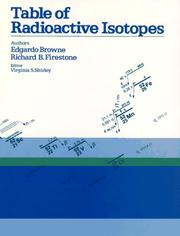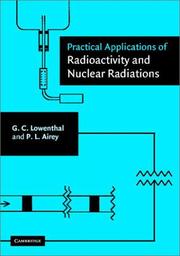| Listing 1 - 10 of 67 | << page >> |
Sort by
|
Book
Year: 1966 Publisher: Paris : Laboratoire Central des Ponts et Chaussées, Service des Publications,
Abstract | Keywords | Export | Availability | Bookmark
 Loading...
Loading...Choose an application
- Reference Manager
- EndNote
- RefWorks (Direct export to RefWorks)
Book
Year: 1952 Publisher: Philadelphia, PA : ASTM (American Society for Testing & Materials),
Abstract | Keywords | Export | Availability | Bookmark
 Loading...
Loading...Choose an application
- Reference Manager
- EndNote
- RefWorks (Direct export to RefWorks)
Book
Year: 1953 Publisher: Philadelphia, PA : ASTM (American Society for Testing & Materials),
Abstract | Keywords | Export | Availability | Bookmark
 Loading...
Loading...Choose an application
- Reference Manager
- EndNote
- RefWorks (Direct export to RefWorks)
Radioactive isotopes --- Radioactive wastes --- Activation analysis --- Treatment --- Radioactive isotopes --- Radioactive wastes --- Activation analysis --- Treatment

ISBN: 047184909X Year: 1986 Publisher: New York (N.Y.): Wiley
Abstract | Keywords | Export | Availability | Bookmark
 Loading...
Loading...Choose an application
- Reference Manager
- EndNote
- RefWorks (Direct export to RefWorks)
Table of Radioactive Isotopes By the Isotopes Project, Nuclear Science Division, Lawrence Berkeley Laboratory, Berkeley. The Table of Radioactive Isotopes is a comprehensive and critical evaluation of the nuclear and atomic properties of radioactive isotopes. The book is especially tailored to the needs of applied users in industry, biology, medicine, and other fields, but serves also as an indispensable reference for nuclear physicists and chemists. Detailed radiation data for about 2000 of the 2755 known nuclides are presented in this up-to-date and concise single-volume book. The main section of the book is organized by mass number (A), with entries for a given A derived from and referenced to the most recent corresponding evaluation in Nuclear Data Sheets or Nuclear Physics. These entries include a mass-chain decay scheme, showing the isotopes for that mass number, some of their properties, and the decay relationships between them. Following the scheme are tables for every isotope, the first of which gives the isotope's atomic number, mass number, element symbol, half-life, decay modes and branchings, mass excess, specific activity, means of production, and natural isotopic abundance. Subsequent tables list the isotope's nuclear and atomic radiations, and include total average energies per disintegration wherever possible. Throughout, the experimental radiation data have been analyzed for statistical consistency, and the resulting best energies and intensities are reported in the tables. Appendices of interest to users of radioactivity data follow the main section of the book. These include graphs and tables pertaining to the following: fundamental constants and conversion factors, standard [gamma]-ray and [alpha]-particle energies and intensities for detector calibration, theoretical internal conversion coefficients, electron-capture subshell ratios, electron binding energies, atomic fluorescence and Coster-Kronig yields, x-ray energies and intensities, Auge
Radioisotopes --- Isotopes radioactifs --- Tables --- -Radioactive isotopes --- Radioactive nuclides --- Radionuclides --- Isotopes --- Nuclear engineering --- Radioactive substances --- Radiochemistry --- Tables. --- -Tables --- Radioactive isotopes --- Monograph
Book
ISBN: 9535149199 9533075104 Year: 2011 Publisher: IntechOpen
Abstract | Keywords | Export | Availability | Bookmark
 Loading...
Loading...Choose an application
- Reference Manager
- EndNote
- RefWorks (Direct export to RefWorks)
The book Radioisotopes - Applications in Physical Sciences is divided into three sections namely: Radioisotopes and Some Physical Aspects, Radioisotopes in Environment and Radioisotopes in Power System Space Applications. Section I contains nine chapters on radioisotopes and production and their various applications in some physical and chemical processes. In Section II, ten chapters on the applications of radioisotopes in environment have been added. The interesting articles related to soil, water, environmental dosimetry/tracer and composition analyzer etc. are worth reading. Section III has three chapters on the use of radioisotopes in power systems which generate electrical power by converting heat released from the nuclear decay of radioactive isotopes. The system has to be flown in space for space exploration and radioisotopes can be a good alternative for heat-to-electrical energy conversion. The reader will very much benefit from the chapters presented in this section.
Radioisotopes. --- Radioactive isotopes --- Radioactive nuclides --- Radionuclides --- Isotopes --- Nuclear engineering --- Radioactive substances --- Radiochemistry --- Geophysics
Book
ISBN: 9282617106 Year: 1990
Abstract | Keywords | Export | Availability | Bookmark
 Loading...
Loading...Choose an application
- Reference Manager
- EndNote
- RefWorks (Direct export to RefWorks)
Radioisotopes. --- MIGRATION --- Radioactive isotopes --- Radioactive nuclides --- Radionuclides --- Isotopes --- Nuclear engineering --- Radioactive substances --- Radiochemistry --- Report
Book
ISBN: 1504407008 Year: 2016 Publisher: New York : IEEE,
Abstract | Keywords | Export | Availability | Bookmark
 Loading...
Loading...Choose an application
- Reference Manager
- EndNote
- RefWorks (Direct export to RefWorks)
Performance specifications and testing methods for the evaluation of handheld instruments (also known as radionuclide identification devices or RIDs) used for the detection and identification of radionuclides, which emit gamma rays and, in some cases, neutrons, are contained in this standard. The specifications for general, radiological, environmental, electromagnetic and mechanical performances are given and the corresponding testing methods are described. The documentation to be provided by the manufacturer is listed as part of the requirements. Normative and informative annexes that provide guidance for the implementation of this standard are also included. (The PDF of this standard is available at no cost compliments of the Department of Homeland Security Domestic Nuclear Detection Office. http://standards.ieee.org/getN42/download/N42.34-2015.pdf). Scope: This standard specifies general, radiological, environmental, electromagnetic, and mechanical requirements,and associated test methods for handheld radionuclide identification devices (RIDs). Successful completion of the tests described in this standard should not be construed as an ability to identify all radionuclides in all environments. Purpose: This standard addresses instruments that are used to detect and identify radionuclides, display gamma-ray exposure rates, and when provided, indicate the presence of neutron radiation. The identification requirements established by this standard are based on the sources and source configurations defined in this standard. When an RID is used operationally, the configuration of a source or object being analyzed is typically unknown, which may cause other radionuclides or isotopes to be identified.
Radioisotopes --- Radioactive isotopes --- Radioactive nuclides --- Radionuclides --- Isotopes --- Nuclear engineering --- Radioactive substances --- Radiochemistry --- Standards. --- Radioactivity --- Instruments
Book
ISBN: 9535165763 9533077484 Year: 2011 Publisher: IntechOpen
Abstract | Keywords | Export | Availability | Bookmark
 Loading...
Loading...Choose an application
- Reference Manager
- EndNote
- RefWorks (Direct export to RefWorks)
The book Radioisotopes - Applications in Bio-Medical Science contains two sections: Radioisotopes and Radiations in Bioscience and Radioisotopes and Radiology in Medical Science. Section I includes chapters on medical radioisotope production, radio-labeled nano-particles, radioisotopes and nano-medicine, use of radiations in insects, drug research, medical radioisotopes and use of radioisotopes in interdisciplinary fields etc. In Section II, chapters related to production of metal PET (positron emission tomography) radioisotopes, 3-dimensional and CT (computed tomography) scan, SS nuclear medicine in imaging, cancer diagnose and treatments have been included. The subject matter will by highly useful to the medical and paramedical staff in hospitals, as well as researchers and scholars in the field of nuclear medicine medical physics and nuclear bio-chemistry etc.
Radiology. --- Radioisotopes. --- Radioactive isotopes --- Radioactive nuclides --- Radionuclides --- Isotopes --- Nuclear engineering --- Radioactive substances --- Radiochemistry --- Radiological physics --- Physics --- Radiation --- Radiology
Book
ISBN: 0738152811 Year: 2007 Publisher: New York : IEEE,
Abstract | Keywords | Export | Availability | Bookmark
 Loading...
Loading...Choose an application
- Reference Manager
- EndNote
- RefWorks (Direct export to RefWorks)
The performance requirements for hand-held radionuclide identifying instruments are described in this standard. The requirements stated are based on instruments used in support of efforts associated with the U.S. Department of Homeland Security.
Radioactivity --- Radioisotopes --- Radioactive isotopes --- Radioactive nuclides --- Radionuclides --- Isotopes --- Nuclear engineering --- Radioactive substances --- Radiochemistry --- Nuclear reactions --- Radiation --- Instruments --- Standards. --- Radioisotopes. --- Instruments.

ISBN: 110711280X 1280416955 9786610416950 0511174012 0511053274 0511153473 0511303459 0511535376 051103962X 9780511039621 9780511153471 9780521553056 0521553059 0521553059 9780511535376 9780521019804 Year: 2001 Publisher: Cambridge : Cambridge University Press,
Abstract | Keywords | Export | Availability | Bookmark
 Loading...
Loading...Choose an application
- Reference Manager
- EndNote
- RefWorks (Direct export to RefWorks)
This book is aimed at scientists and engineers wanting to use radioisotopes and the emitted ionising radiations competently but without seeking expertise. It describes decay and stability criteria, necessary precautions to ensure radiation protection and the detection of alpha, beta and gamma rays including spectrometry. There are comments on calorimetry, liquid scintillation counting, how to use secondary standard instruments, high resolution detectors and how to calculate counting results estimating uncertainties and allowing for the statistics of radionuclide decays. The book's principal purpose is to encourage radionuclide applications which can be done safely, reliably and accurately. It describes industrial and scientific applications of alpha, beta, and gamma rays, neutrons and high energy radiations. This book will be of particular interest to scientists and technologists, teachers and students, helping them to work with radioisotopes safely, efficiently and reliably.
Radioisotopes. --- Radioactivity. --- Nuclear reactions --- Radiation --- Radioactive isotopes --- Radioactive nuclides --- Radionuclides --- Isotopes --- Nuclear engineering --- Radioactive substances --- Radiochemistry --- Radioisotopes --- Radioactivity --- Industrial applications.
| Listing 1 - 10 of 67 | << page >> |
Sort by
|

 Search
Search Feedback
Feedback About UniCat
About UniCat  Help
Help News
News